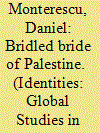|
|
|
Sort Order |
|
|
|
Items / Page
|
|
|
|
|
|
|
| Srl | Item |
| 1 |
ID:
092915


|
|
|
|
|
| Publication |
2009.
|
| Summary/Abstract |
Through ethnographic and archival research centered in Jaffa, this article analyzes how the image of the Jewish-Arab mixed city has been represented and (re)produced in the Zionist historical imagination since the establishment of the state of Israel to the present. Vacillating between romantic historicity and political violence, the image of Jaffa poses a political and hermeneutic challenge to the territorial project of urban Judaization, which ultimately failed to define and establish the national-cum-cultural identity of this "New-Old" city. This failure, I argue, results in a persistent pattern of semiotic ambivalence which, from the Jewish-Israeli point of view, positions Jaffa both as a source of identity and longing (in the distant past) as well as a symbol of alterity and enmity (in the recent past)- an object of desire and fear alike. As such, Jaffa and other ethnically mixed towns (including Ramle, Lydda, Haifa, and Acre) occupy a problematic place in Israeli and Palestinian political and cultural imagination. A bi-national borderland in which Arabs and Jews live de facto together, these cities bring to the fore, on the one hand, the paradox of Palestinian citizens in a fundamentally Jewish state, while simultaneously suggesting, by the very spatial and social realization of "mixed-ness," the potential imaginary of its solution. Unfolding through four distinct historical modalities of urban Orientalism, this article historicizes the highly politicized image of the Jewish-Arab city and the discourse on its future. These discursive formations reconfigured the public space that enabled, paradoxically since the October 2000 events, new political claims for equal citizenship, bi-national cooperation, and Palestinian presence.
|
|
|
|
|
|
|
|
|
|
|
|
|
|
|
|
| 2 |
ID:
084758


|
|
|
|
|
| Publication |
2008.
|
| Summary/Abstract |
Studies of Middle Eastern urbanism have traditionally been guided by a limited repertoire of tropes, many of which emphasize antiquity, confinement, and religiosity. Notions of the old city, the walled city, the casbah, the native quarter, and the medina, sometimes subsumed in the quintessential "Islamic city," have all been part of Western scholarship's long-standing fascination with the region. Etched in emblematic "holy cities" like Jerusalem, Mecca, or Najaf, Middle Eastern urban space is heavily associated with the "sacred," complete with mystical visions and assumptions of violent eschatologies and redemption.
|
|
|
|
|
|
|
|
|
|
|
|
|
|
|
|
|
|
|
|
|